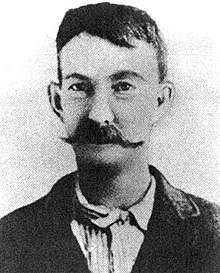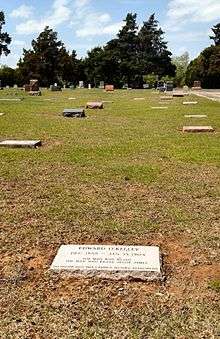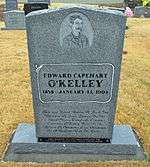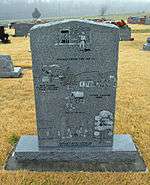Edward Capehart O'Kelley
Edward Capehart O'Kelley (October 1, 1857[2] – January 13, 1904) was the man who murdered Robert Ford, who had killed the famous outlaw Jesse James to receive a bounty. He was the subject of a 1994 book by O'Kelley's great-great-niece.[3]
Edward Capehart O'Kelley | |
|---|---|
 Edward Capehart O'Kelley c. 1890 | |
| Born | October 1, 1857 |
| Died | January 13, 1904 (aged 46) |
| Cause of death | Gunshot wounds |
Over the years, historians and contemporary newspapers variously spelled O'Kelley's surname as "Kelly" or "O'Kelly", sometimes mistakenly using the letter "O" as his middle initial.[1]
Early years
Little is known of O'Kelley's youth, although his birthplace is reported as Harrisonville, Missouri.[1] His mother was Margaret Ann Capehart (6 July 1836 – 27 July 1903), but at the time of her 14 July 1857 marriage to Dr. Thomas Katlett O'Kelley (20 October 1833 – 9 October 1923) she was already pregnant with Edward. It is believed that Thomas was not Edward's father. Edward was a child during the American Civil War. In Thomas' Civil War Veteran Pension File, where Thomas was required to list all his children and their dates of birth, Edward is not included on the list.[4]
The murder of Robert Ford
Robert Ford befriended outlaw Jesse James in 1882, when he and his brother Charley joined his gang. They lived with James and his family for a time. Ford shot James in the back of the head to collect a state bounty of $5,000.[5] By 1892, he operated a tent saloon in the silver mining camp of Creede, Colorado.[6]
On June 8, 1892, while Ford was preparing to open his saloon, O'Kelley walked into the tent with a shotgun. Ford was turned away from the front entrance. O'Kelley called out, "Hello Bob." As Ford turned around to see who spoke, O'Kelley fired his shotgun, hitting Ford in the neck and killing him instantly.[7]
O'Kelley never explained why he had shot Ford. One theory involves the accusation that O'Kelley had stolen Ford's diamond ring, and the dispute escalated. O'Kelley was initially imprisoned for life, though his sentence was later reduced to 18 years;[1] in the end, O'Kelley only served around 9 years at the Colorado State Penitentiary before being released because of a 7,000-signature petition in favor of his release and a medical condition.[8]
After incarceration
After his release, O'Kelley moved to Oklahoma City. Shortly after his arrival in town, he was recognized by Otto Ewing of the Southern Club, a local gambling house. It is claimed that Ewing had been connected with Ford's saloon in Creede, and may even have been there when O'Kelley killed Ford. Ewing told people that O'Kelley was a dangerous man and best avoided.
In December 1903, police officer Joe Burnett arrested O'Kelley as a "suspicious character". O'Kelley was staying at the Lewis Hotel. He frequented the saloons on West 4th and 2nd Streets, which were known as the hangouts of criminals in the early years of the city.
Personal life
Nicknamed "Red", O'Kelley married a relative of the Younger brothers.[1]
Death

On 13 January 1904, O'Kelley was arrested by a police officer named Bunker. O'Kelley was released and went to his hotel, where he commented to others that the police had better not try to arrest him again. That evening, Officer Joseph Grant "Joe" Burnett (1867-1917) was walking his beat on the south side of First Street, in front of the McCord & Collins building. Burnett encountered O'Kelley and greeted him politely. In reply, O'Kelley struck at the lawman and drew a revolver. As O'Kelley struck at the officer again, Burnett grabbed the gun with his left hand.
The two men began to wrestle in a life-and-death struggle. O'Kelley fired his pistol several times, trying to shoot the policeman. At the same time, O'Kelley repeatedly called Burnett foul names, saying he was going to kill him. Burnett called out for help repeatedly. O'Kelley did not hit Burnett with his gunfire, but Burnett did receive powder burns on one ear. Once out of ammunition, O'Kelley used his teeth to bite chunks out of both of the policeman's ears.
A friend of O'Kelley came to his aid and fired one shot at the policeman, but then lost his nerve and ran away. R. E. Chapin witnessed the fight from the rear of the building on West Main Street and telephoned police headquarters. Finally, A. G. Paul, a railroad baggage man, came running from the depot. He grabbed O'Kelley's hand, thus freeing Burnett's gun hand. The policeman immediately fired two shots and killed O'Kelley.
There were two bullet holes in the back of Burnett's overcoat, and the left hip pocket was torn by a bullet. By the time friends reached his side, Burnett's gloves were burned and his clothing was on fire. They called an ambulance to take O'Kelley's body to the morgue at Street and Harpers furniture store. His body had a bullet wound in his left leg just above the knee. The fatal shot entered his head just behind the left temple and exited behind the right ear.
O'Kelley's body remained at the morgue for about two weeks. A number of people, including Otto Ewing, identified the dead man as the killer of Robert Ford. The warden of the Colorado State Penitentiary, where O'Kelley had been imprisoned, sent city authorities a description and photograph of O'Kelley, leaving no doubt of his identification.
On 28 January 1904, O'Kelley was interred at Fairlawn Cemetery in north Oklahoma City. The county provided the casket and service, at a cost to the taxpayers of $12.50.
Burnett continued with the Oklahoma City Police Department, serving as a Captain and later as assistant Chief of Police. He died on 20 July 1917 of paralysis after a stroke, at St. Anthony's Hospital. Burnett was buried in a marked grave in the same cemetery as the man he killed.[9]
Memorial


A memorial for Edward O'Kelley stands in the Patton United Methodist Church cemetery, on Country Road 878, in Patton, Missouri. The monument is engraved on both sides.
The front of the monument reads:
- Edward Capehart O'Kelley
- 1858 - January 13, 1904
- Shot and killed Robert N. Ford,
- the murderer of Jesse James, in the
- Silver mining camp at Creede,
- Colorado. O'Kelley died in the
- streets of Oklahoma City, Oklahoma
- in a gunfight with the law.
The back of the memorial contains engraved scenes from 1890s Creede Colorado, where O'Kelley fatally shot Ford. The monument was erected through the efforts of Judith Ries, O'Kelley's great-great niece.
References
- O' Neal, Bill (1991), "Kelly, Ed O.", Encyclopedia of Western Gunfighters, University of Oklahoma Press, p. 174
- "O'Kelleys in America". Archived from the original on 2013-12-12. Retrieved 2012-10-05.
- Ed O'Kelley: The Man Who Killed Jesse James' Murderer, by Judith Ries
- Thomas Katlett O'Kelley's Civil War Veteran Pension File
- Hanes, Elizabeth (June 20, 2012). "Jesse James Wanted Poster Goes Up for Auction". History. Retrieved July 1, 2015.
- Carlynn, Trout. "Robert Ford". The State Historical Society of Missouri. Retrieved July 1, 2015.
- Craughwell, Thomas J. (2011). Busted: Mugshots and Arrest Records of the Famous and Infamous. New York: Black Dog and Leventhal Publishers, Inc. p. 357. ISBN 978-1-57912-865-4. Retrieved 4 October 2019.
- Hansen, Ron (1983). The Assassination of Jesse James by the Coward Robert Ford. Knopf Doubleday Publishing Group. p. 304. ISBN 9780394516479.
- "Half of Force Given Leave to Attend Joe Burnett's Funeral". Oklahoman. July 22, 1917. Retrieved May 8, 2020.
Sources
- Ries, Judith (1994). Ed O'Kelley: The Man Who Murdered Jesse James' Murderer. St. Louis, Mo.: Patches Publication. p. 119. ISBN 0-934426-61-9.